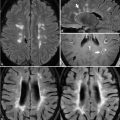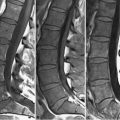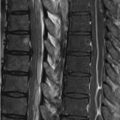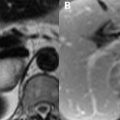72 Pediatric Abdominal Disease MRI of the pediatric abdomen poses several challenges: in younger patients (<6 years old), it is difficult to appropriately minimize voluntary patient motion. As such, conscious sedation may be necessary. Persistent physiologic motion due to respiration and bowel peristalsis may be minimized by utilization of sequences with short acquisition times, possibly to the detriment of image quality, or employing motion robust imaging techniques such as PROPELLER (periodically rotated overlapping parallel lines with enhanced reconstruction). Pediatric abdominal masses most commonly involve the kidney with nephroblastoma (Wilms tumor) being the most common, often appearing as a large heterogeneously hyperintense and hypointense mass on T2WI and T1WI, respectively. Inhomogeneity on T2WI may result from hemorrhagic, cystic, or necrotic foci, the latter identifiable by a lack of contrast enhancement. Figure 72.1A illustrates contrast-enhanced FS T1WI of a large, somewhat homogeneously enhancing nephroblastoma. Because normal retroperitoneal lymph nodes are not commonly visible in children, the presence of such nodes, which often enhance and demonstrate increased SI on T2WI, is suspicious for metastases. Infiltration of the perirenal fat or renal veins is an important determination, the latter manifesting as loss of normal vascular flow voids on FSE imaging or as luminal hypointensity on GRE images. MRV may further delineate such spread if invasion is questioned, as this finding may alter the surgical approach. The true origin of a retroperitoneal mass in a child may be difficult to delineate: a neuroblastoma arising from the adrenal medulla or paraspinal sympathetic chain may appear similar. A neuroblastoma is shown on the T2WI of Fig. 72.1B
![]()
Stay updated, free articles. Join our Telegram channel

Full access? Get Clinical Tree








